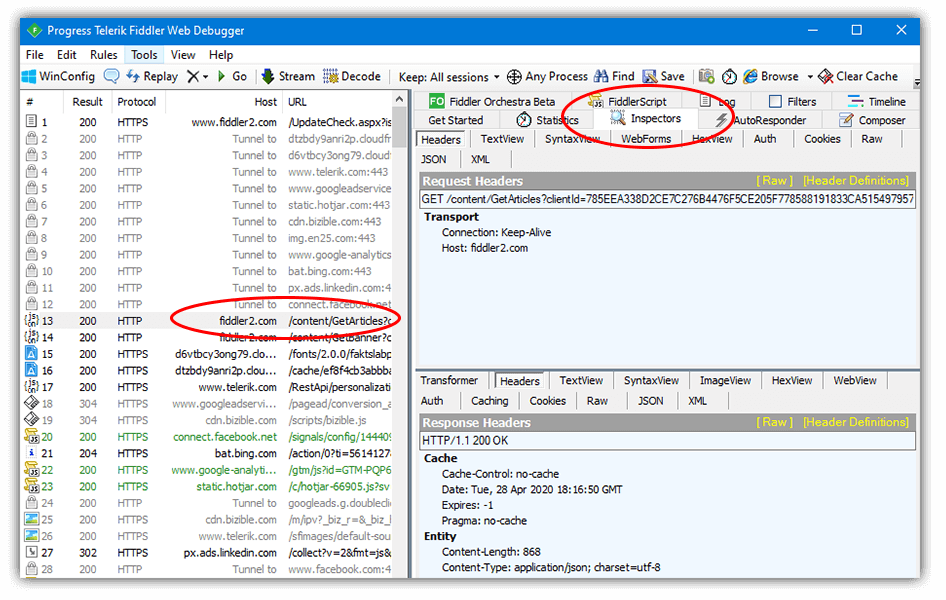
Screenshot of Fiddler Everywhere logging HTTP/S network calls | |
| Original author(s) | Eric Lawrence[1] |
|---|---|
| Developer(s) | Telerik |
| Initial release | 6 October 2003; 17 years ago[2] |
| Operating system | Windows and later, macOS, and Linux[3] |
| Type | Packet analyzer |
| Website | www.telerik.com/fiddler |
Fiddler is a debugging proxy server tool used to log, inspect, and alter HTTP and HTTPS traffic between a computer and a web server or servers. Fiddler was originally written by Eric Lawrence while a Program Manager on the Internet Explorer development team at Microsoft.[1]
The usage of the name “Fiddler” has broadened to encompass additional products and tools provided by Progress Telerik including Fiddler Classic, Fiddler Everywhere Pro, Fiddler Core, Fiddler Cap, and Fiddler Jam.
Features[edit]
Fiddler captures HTTP and HTTPS traffic and logs it for the user to review. The logging is performed by implementing man-in-the-middle interception using self-signed certificates.[4] Fiddler can be used to edit network sessions by setting breakpoints to pause the processing of requests and permitting the alteration of the request and/or response.
“Imbued with the dust, grit, and grime of Galveston at the close of the Civil War, Simon the Fiddler immerses readers in the challenges of Reconstruction. Jiles brings her singular voice to the young couple's travails, her written word as lyrical and musical as Simon's bow raking over his strings. Fiddler is a proxy server, logging and modifying connections between your computer and the Internet over HTTP. Each process that Fiddler manages is available in a table from the main interface. The statistics tab of Fiddler displays a summary of all of the objects selected while a pie chart displays the types of data connections to a web site. People also search for. Fiddler's Green is a Golf Retail Store located in Eugene, Oregon. Spring/Summer Hours 9:00am-7:00pm everyday. Fiddler's Green Golf Center 91292 Hwy 99.
The Fiddler Ecosystem offers different products and tools to address specific use cases:
Fiddler On The Roof Movie
- Fiddler Classic is the original (and free) debugging proxy tool for Windows only.
- Fiddler Everywhere Pro is the next generation of Fiddler. Fiddler Everywhere Pro runs on macOS, Windows, and Linux, and has built-in team collaboration and an enhanced UI.
- Fiddler Core is a .NET library allowing you to capture and modify HTTP and HTTPS traffic.
- Fiddler Cap is a lightweight Windows-only version of Fiddler designed for non-technical users to capture web traffic and then share the data within the team for debugging.
- Fiddler Jam (Pilot) is a web-based troubleshooting solution for support teams looking to capture web traffic, web logs and web app screenshots without requiring any programming.
History[edit]
On 6 October 2003, Eric Lawrence released the first official version of Fiddler.[2]
On 12 September 2012, Fiddler was acquired by Telerik and the original author joined the company to work on Fiddler on a full-time basis.[5]
On 22 December 2015, Eric Lawrence announced[6] he was leaving Telerik and the Fiddler project.
On 3 October 2019, Progress Telerik released version 5 of Fiddler.[7]
On 1 June 2020, Progress Telerik released a beta version of Fiddler Everywhere.[8]
On 18 September 2020, Progress Telerik announced the RTW version of Fiddler Everywhere 1.0.[9]
See also[edit]
- Packet analyzer – a computer program or piece of computer hardware that can intercept and log traffic that passes over a digital network
- Charles Proxy – proxy server for debugging web traffic, similar to Fiddler
References[edit]

- ^ abLawrence, Eric (6 June 2005). 'HTTP Performance'. IEBlog. MSDN (Microsoft).
- ^ ab'Fiddler v1.x Release History'. Telerik. Retrieved 7 October 2019.
- ^'Fiddler Web Debugger - Get Fiddler'. Retrieved 18 September 2019.
- ^Lawrence, Eric (January 2005). 'Fiddler PowerToy - Part 1: HTTP Debugging'. MSDN (Microsoft corporation). Retrieved 7 October 2019.
- ^Lawrence, Eric (September 2012). 'Fiddler Telerik'. Fiddler. Archived from the original on 12 September 2012.
- ^Lawrence, Eric (December 2015). 'Fiddler - A Segue'. Telerik.
- ^Velikov, Kamen (October 2019). 'What's New in Fiddler for Windows v5.0.20194'. Telerik.
- ^Velikov, Kamen (June 2020). 'Fiddler Everywhere v0.10 is Here!'. Telerik.
- ^Pereira, Jonathan (September 2020). 'Fiddler Everywhere 1.0 is Here!'. Telerik.
Further reading[edit]
- Lawrence, Eric (16 February 2016). Debugging with Fiddler: The complete reference from the creator of the Fiddler Web Debugger 2nd Edition. ISBN978-1511572903.
External links[edit]
- Official website
Fiddler Logs
You can use Fiddler Everywhere to capture and inspect traffic that comes from Android devices and emulators. This article describes the required steps.
| Product | Fiddler Everywhere |
| Product Version | 1.0.2 and above |

Prerequisites
- Fiddler Everywhere client installed on your machine.
- The machine running Fiddler Everywhere and the Android device must be discoverable on the same network, for example, 192.168.0.0

Configure Fiddler Everywhere
Enable the remote connections in Fiddler Everywhere via Settings > Connections > Allow remote computers to connect
Note the IP address of the machine where Fiddler Everywhere is running. You can use built-in OS tools to obtain the IP address (like ipconfig on Windows or ifconfig on Linux) or the Fiddler Everywhere connection status icon on the lower right-hand side of the client.For demonstration purposes, let's assume that the local IP of the Fiddler Everywhere machine is 192.168.0.101
Depending on the environment, an Android emulator might not be able to support ICMP, used for 'ping'.
Configure Android Device
The steps below are applicable for real devices and emulators (a.k.a. AVDs). There are significant differences in how emulators access the internet via the local network. To configure your device, apply the steps that correspond to your use case:
Check Android device IP address
- Open the connected Wifi and tap on Settings.
- Expand Advanced Settings.
- (Real devices only) Note the IP address of the real Android device. For demonstration purposes, let's assume the device IP is 192.168.0.222
- (Android emulators only) Note the IP address of the emulator. In most cases, the Android emulator IP is of kind 10.0.2.XXX (Note: For GenyMotion emulator, the IP by default is 10.0.3.XXX).
Modify Android device Proxy
- Open the connected Wifi and tap on Settings.
- Select Edit and expand Advanced Settings. You might have to touch and hold the connected network's name on older Android versions and then tap on Modify and expand Advanced Settings.
- On Proxy, select Manual proxy.
- (Real devices only) Enter the IP address of the computer running Fiddler Everywhere, for example, 192.168.0.101.
- (Android emulators only) Enter the IP address of the emulator's gateway. In most cases, the Android emulator gateway IP is 10.0.2.2 (Note: For the GenyMotion emulator, the default gateway IP is 10.0.3.2).
- Enter the proxy port. Use the port configured in the Fiddler Everywhere client. The default port is 8866 (it could be changed from the Fiddler Everywhere connections settings).
- Tap Save.
Install the Fiddler root certificate on the Android device.
- Open a browser on the Android device and type the Fiddler echo service address: http://ipv4.fiddler:8866
- Tap the option to download the certificate.
- In the prompt window, enter a certificate name and press Save.
- Install the downloaded Fiddler certificate in the device certificate storage (the settings location depends on the Android version but usually is located under Settings > Security > Encryption & Credentials > Install a certificate)
Inspect Browser Traffic
With all of the above done, you can immediately monitor HTTP/HTTPS traffic from mobile browsers. For example, open a Chrome browser on your Android device, type an address of your choice, and observe the traffic being captured in the Live Traffic section of Fiddler Everywhere.
Fiddler On The Roof Movie
Once you’re done debugging, don’t forget to remove the WiFi proxy from your Android device.
Inspect Android Application Traffic
Fiddler Crab
You can monitor traffic from apps in active development (an application for which you have access to the codebase). For Android API 24 and above, you also need to add the following code to the app:
Add this to Android/src/main/res/xml/network_security_config.xml:
In the AndroidManifest.xml file, reference the
network-security-configfrom step 1 via a parameter in the application tag:For example:
Rebuild the app, and you can start monitoring its HTTP/HTTPS traffic.
Want to learn more about using Fiddler Everywhere to debug mobile apps? Check out our webinar on mobile app debugging with Fiddler!